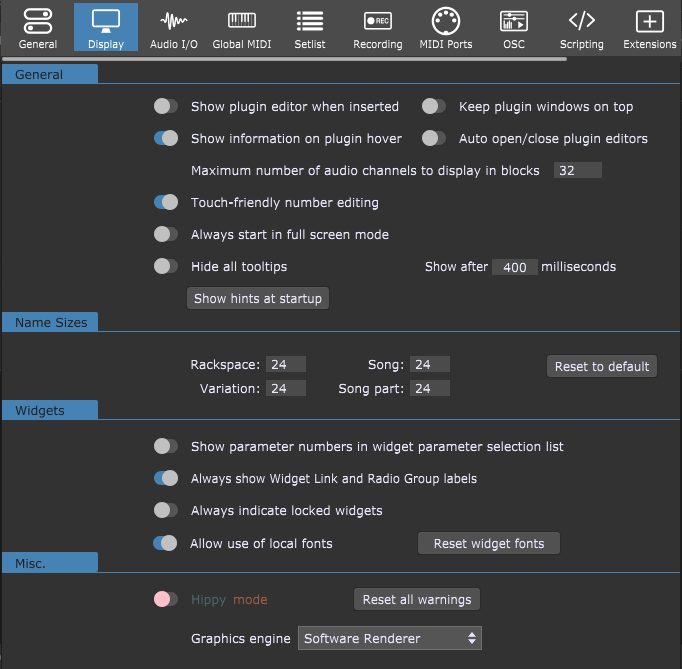The Display tab appears when the Display... menu item is chosen in the Options menu:

Show plugin editor when inserted - when checked, the plugin editor window will open automatically whenever a plugin is inserted. Disable this feature if you prefer to insert and route your plugin blocks first and edit them all later.
Keep plugin windows on top - when enabled, open plugin window editors always appear on top of other windows.
Show information on plugin hover - when enabled, moving the mouse over blocks in the Wiring view will cause a pop-up tooltip to appear with the information about the plugin (plugin's name, type, format and latency).
Auto open/close plugin editors - enabling this toggle button opens/closes plugin editors automatically as you switch from one rackspace to another. Note that this option doesn't open/close editor windows of all plugins in a rackspace, but only the currently opened ones.
Maximum number of audio channels to display in blocks - this option prevents plugins from showing more than a specified number of audio channels. Some plugins have a large number of audio channels, most of which may never be used, making their blocks unwieldy to view and causing them to take up a lot of horizontal space in the Wiring view. Note that the value entered here does not apply to the audio interface Audio In and Audio Out blocks. You can also configure the maximum number of audio channels available on individually inserted plugins (check this chapter to learn more).
Touch friendly number editing - if you run Gig Performer on a device such as Microsoft Surface, you may want to activate this option as it shows a large key pad for some dialogs and allows you to enter the desired values easier with your finger.
Always start in full screen mode - enable this option if you want to always start Gig Performer in full screen mode. Press the Esc key or use the key combination Ctrl+Alt+F (or Cmd+Option+F on Mac) to exit the full screen mode.
Hide all tooltips - when you move your mouse over some item (a button, a slider, or an option, for example), a little tooltip window will pop up to explain the purpose of that item. Once you become well acquainted with Gig Performer or if you find pop-up tooltips to be annoying, you can choose to prevent them from being displayed by checking this box. Note: all tooltips are hidden except the one that shows up when you hover over the plugin block in the Wiring view and which can be disabled separately (see Show information on plugin hover).
Show after X milliseconds - allows you to set the delay from 400 to 4000 milliseconds before a tooltip appears.
Show hints at startup - by default, every time you create a new gig a hint dialog pops up. You can browse through many useful hints and tips in that dialog. If you disable showing hints at startup, clicking on this button to re-enable showing hints at startup.
Name sizes - in this section you can configure the name size of rackspaces, variations, songs, and song parts (from 12 to 48). Click the Reset to default button to reset all fields to 24.
Show parameter numbers in widget parameter selection list - when this toggle button is turned on, then each parameter name is displayed prefixed with its unique parameter number. This can be useful if you need to control parameters from GPScript or OSC. In both of these cases, parameter numbers rather than names are used:

Always show Widget Link and Radio Group labels - when you gang multiple widgets together in a Widget Link group (lettered A through Z) or a Radio Group (numbered from 1 to 99), the corresponding character (a letter or a number) is displayed on the top left of the widget while in Edit mode. If you want the widget groups labels to stay always (i.e. even if you are not in Edit mode), then turn on this toggle button.
Always indicate locked widgets - if this toggle button is turned on, then the widget lock indicator will be displayed all the time (i.e. even if you are not in Edit mode).
Allow use of local fonts - clicking on this toggle button allows you to use other third-party fonts that are installed on your computer.
Reset widget fonts - click on this button to reset all widget labels back to the Gig Performer's default system font.
Reset all warnings - clicking this button will reset all "Don't show again" warnings in various dialogs.
Graphics engine - this section is available on Windows (macOS users always use the CoreGraphics renderer). Clicking on this dropdown menu allows you to select the graphics library that Gig Performer uses for its displays:

•Software Renderer - this choice means that Gig Performer uses your computer's CPU to render the display without the help of any graphics library optimizations. Windows users without high-performance graphics in their machines will likely get the best results with this setting.
•OpenGL Renderer - on systems with high-performance graphics capabilities, OpenGL may provide better visual quality, as such cards are often optimized to run OpenGL.
Depending on the graphics card in their machine, Windows users may find that OpenGL Renderer delivers better quality than Software Renderer.